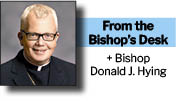
In last week’s column, I discussed Reinhold Niebuhr’s three-fold model of how Christians relate to the culture around them.
In this column, I will apply his thinking to Catholics and their perception of the Second Vatican Council.
Much debate, controversy, and disagreement have marked the understanding, acceptance, and implementation of Vatican II in the ensuing 58 years since its conclusion.
Clearly, St. John XXIII, who convened the Council in 1962, saw it as a needed renewal of the Church for the sake of evangelizing the modern world.
His desire was not to alter Church teaching or invent a new ecclesiology but to summon the vast energies of global Catholicism in a renewal of the faith for the sake of the mission to preach the Gospel and make disciples.
He wanted to reach out and engage a world haunted by two devastating world wars; the threat of nuclear holocaust; the rise of atheism, agnosticism, and communism; and a growing disparity between the wealthy and the poor.
In light of Niebuhr’s three models, John XXIII embraced “Christ transforming culture.”
Disagreeing voices
Even before the council finished in 1965, influential voices disagreed with its vision and directives, and perhaps even more with its implementation, especially in the area of liturgy, viewing it as a betrayal of the faith, as a fundamental rupture with previous councils and with Sacred Tradition itself. The many excesses, confusions, errors, and even some heretical thinking which marked the hasty implementation of Vatican II — at least here in the United States — simply confirmed the opinion of those who profoundly disagreed with the council from the beginning.
Embracing the model of “Christ against culture,” these critical voices have only grown louder in recent years.
Some have moved from rightfully criticizing the errors made by some of the Council’s implementation to asserting that Vatican II should never have happened at all, that it was an illegitimate council, that the Novus Ordo Mass is questionable at best or even invalid, and that the Tridentine Mass is the only proper form for the Eucharist.
Some have even slipped into a sedevacantism, insisting that there has been no legitimate pope since Venerable Pope Pius XII. These opinions have only grown in intensity, fueled by social media and Pope Francis’ restrictions on the Traditional Latin Mass.
The opposite school of thought asserts that Vatican II did not go far enough and that the reforms and changes wrought by the council were just the beginning of an unending movement of change and novelty.
Invoking the often quoted “in the spirit of Vatican II,” these voices would advocate for fundamental changes in Church doctrine and practice, including Christology, ecclesiology, governance structures, the priesthood, sexuality, and human life.
Like those who oppose Vatican II, these folks would view the council as a fundamental rupture, but a needed and good rupture, from previous councils and the Sacred Tradition itself.
Embracing the model of “Christ equivalent to culture,” they would want the Church to constantly adapt Herself to changing societal norms in order to be relevant. The German Synodal way is a primary current example of this whole dynamic.
A need for healing and truth
Both of these groups are very loud, discontented, and angry in their perception that the Church is fundamentally on the wrong path.
Their opinions daily fill the mailbox of every bishop in the country because we, bishops, are never liberal or traditional enough for them.
I readily agree that much in the Church needs transformation and conversion, and we should always look first to ourselves in need of profound conversion of heart.
Confusion abounds, and at times a fundamental lack of clarity about Church teaching can legitimately puzzle the faithful. Divisions even exist among bishops and priests.
This state of things needs healing, correction, and unity in the Truth of Christ.
In these turbulent times, it is of utmost importance to remind everyone that the Catholic faith does not essentially change and that every Church council can only deepen and expand our collective understanding, expression, and practice of the Christian faith given to us by Christ Himself in the context of the Church He founded.
We have Sacred Scripture, Sacred Tradition, and the Magisterium, and also the concrete expressed clarity and certainty of the Church’s teaching found in the Catechism of the Catholic Church.
As Pope Benedict asserted, himself a participant at the deliberations of the Second Vatican Council, its motivations, teachings, and vision are in continuity with the whole Tradition of the Church.
He clearly rejected the notion of rupture, as do the majority of practicing Catholics today.
Most of our people want to love Christ, know, and live their faith as it has been given to us by the Church, witness the Gospel to the world, assist at the Holy Sacrifice of the Mass solemnly and reverently celebrated, embrace a deep prayer life, live in their families — as holy spouses, parents, and children — and love their neighbors as Christ did.
This vision of “Christ transforming culture” is how Catholicism has always understood itself and is the guiding force of both Go Make Disciples and Into the Deep.
The Acts of the Apostles is the blueprint for how to evangelize and transform the world for Christ.
Those first disciples boldly proclaimed the resurrection of Jesus, loved unconditionally and sacrificially, and were willing to die for the Gospel.
They neither hid from the world in a separate culture of withdrawal nor did they simply adapt themselves to the errors of the age. God calls us to do the same.

